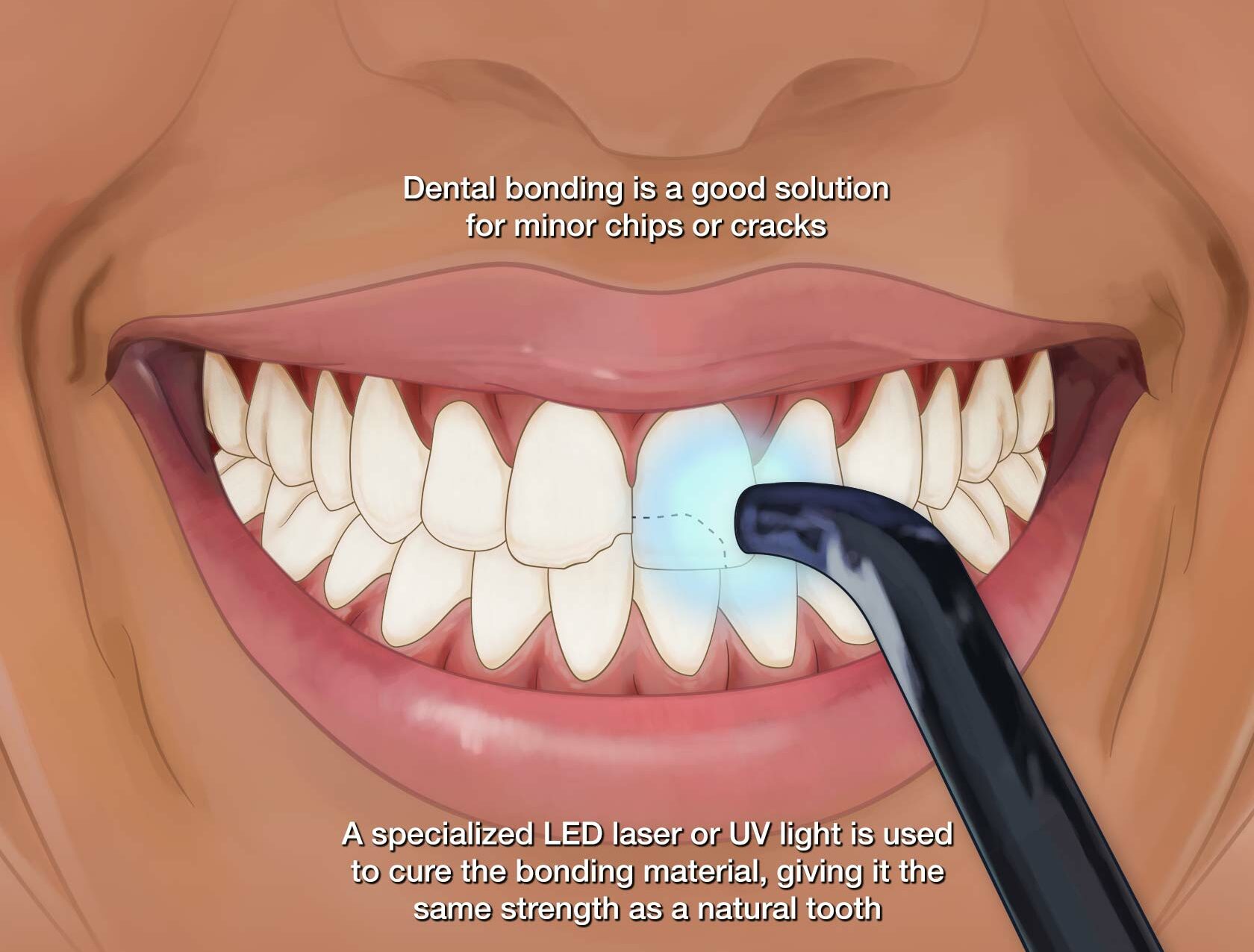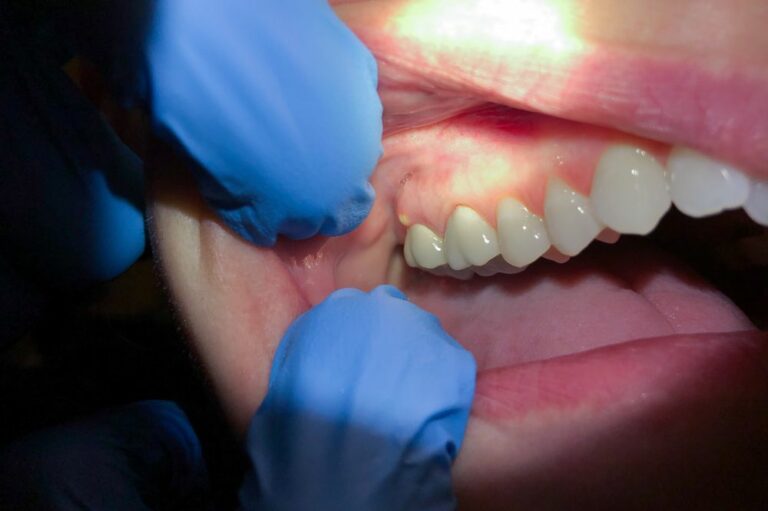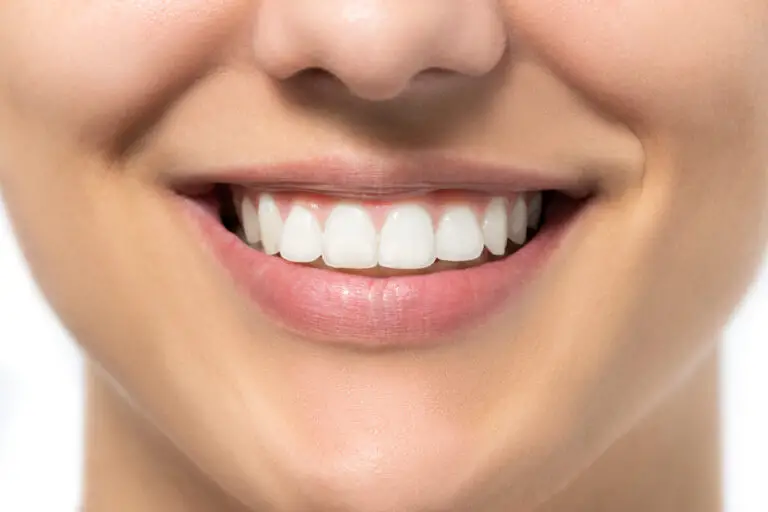Dental bonding is a common procedure your dentist might suggest in the case of a chipped tooth or another cosmetic issue with your natural teeth. The fact that it’s a common and simple procedure, as well as the fact that it’s considered “cosmetic” doesn’t mean that it’s not important or that it can’t be quite pricey.
So, how much is dental bonding, what is it exactly, and should you do it even if you don’t have dental insurance?
What is Dental Bonding Exactly?
Dental bonding – not to be confused with bonded dental bridges – is a simple procedure similar in principle to filling up cavities. The difference is that bonding is done when a part of the tooth chips off and an artificial bonding material needs to be added in the place of the missing piece so that the tooth looks and functions as normal.
The way this is done is as follows:
- The dentist first cleans your teeth and prepares the particular tooth that needs to be bonded for the procedure.
- An etching solution is applied on the tooth’s surface, creating a rough texture that the composite resin will more easily bond to.
- After that, the dentist applies a thin layer of the composite bonding resin on top of the etching solution.
- The dentist then shapes the still-soft resin in the shape of a tooth and makes sure it fits the shape of the missing piece as closely as possible so that it looks natural and functions as a normal tooth would.
- The last part of these dental procedures is the use of a special ultraviolet light that hardens the tooth-colored composite resin so that it turns into an actual functional tooth piece.
All that can be done to fix cracks and even stains, not just chipped pieces. Here’s a quick video from the American Dentist Association (ADA) if you want a more visual explanation.
All this usually takes somewhere between 30 and 60 minutes for a single tooth bonding, depending on how fast the dentist is working and the exact size, nature, and location of the chipped piece. If you need more bonded teeth done, the procedure may take longer or extend into several separate days.
If, after the bonding procedure is done, you feel that something is off, the tooth isn’t shaped exactly as it should be, or anything of the sort – tell your dentist immediately so that they can fix any possible imperfection that might contribute to the way you chew or feel.
If the dentist you go to is competent, however, and if you’ve given them adequate information about how the bonding felt during the procedure, everything should be fine. So, all in all, you can see that dental bonding is a pretty simple yet versatile treatment that can fix chipped teeth of almost any type and severity in often less than an hour. But how much does it cost?
How Much is Dental Bonding?
Dental bonding isn’t as expensive as many other dental procedures. If you’re worried that you’d be slapped with a 4-digit bill and that’s why you’ve been postponing the fixing of your tooth, you can rest assured that the bonding almost certainly won’t cost all that much as long as we’re talking about a single tooth and as long as there aren’t any other complications.
So, the average cost of dental bonding in the US is typically between $100 and $500 depending on the size and severity of the issue. Do keep in mind that your dentist may offer to fix other issues too, however – cavities, deep cleaning, filling a root canal, or anything similar.
We’re not counting those into the average costs as those are separate issues even if they often happen on the same tooth or get resolved in the span of a single dental visit. So, the dental bonding costs themselves are rarely all that high, especially compared to other similar but significantly more expensive procedures such as porcelain veneers or crowns.
Does Insurance Cover the Cost of Dental Bonding?

If you have dental insurance you may walk into your dentist’s office feeling confident that you’ll barely need to pay anything for this procedure. If you do you may end up being disappointed, however, as most insurance providers consider dental bonding to be a cosmetic dental procedure and, as such, don’t offer coverage for it. So, it’s likely that you’ll need to pay the full price out-of-pocket even if you’re insured.
Of course, while the dental bonding procedure is counted as cosmetic dentistry, it does have practical and health-related implications too. If you’re bonding a cracked tooth, this can help protect the tooth from breaking or infection from developing.
Similarly, if you’re bonding in place of a chipped-off piece, this will allow your chewing to continue functioning as normal and it will prevent tooth decay, further deterioration of the tooth. These and other health benefits of dental bonding restoration are, unfortunately, not enough for insurance companies to bondings as more than cosmetic procedures.
There are some insurance plans that will cover tooth bonding, however, those are few and far between. So, it’s best to check with your insurance provider ahead of time so that you know whether you’re covered or whether you’d need to have a different way of paying for the procedure.
How Long Does Dental Bonding Last?

A big part of the whole “cost/benefit” analysis people often miss out on is how long does a tooth bonding last and when you are going to need a repeated bonding treatment.
The bad news is that dental bonding is almost never permanent – sooner or later the bonding treatment will need to be fixed or redone. The good news, however, is that with good oral hygiene, your bonded tooth can remain perfectly fine just as it is for over a decade before a second bonding (or a different procedure) needs to be done.
What to do after dental bonding?
Proper oral hygiene means the normal things – floss and brush your teeth regularly, and so on. However, it also means avoiding certain hard foods that can damage your bonded tooth when you bite down too hard and necessitate repair as a result of that. This isn’t as restrictive as it sounds – you should still be able to eat the vast majority of things you want, just avoid the hardest of the hard foods such as certain types of candy that aren’t meant to be chewed on.
It also means avoiding certain drinks and other things that can change the color of the bonding compound as it’s never 100% stain-resistant. These typically include things such as coffee, red wine, sauce, smoking tobacco, and other similar things. Of course, if you’re not worried about discoloration because the bonded tooth isn’t visible, that’s another question.
These things should typically be explained in detail during your consultation before the procedure is done, of course. Overall, however, keep in mind that a good bonding should be durable enough not to interfere with your regular eating habits, and the discoloration we’re talking about from stuff such as red wine and coffee doesn’t happen overnight – it’s just something that will affect your tooth’s looks years down the line.
For example, regular tobacco use will make your bonded tooth get a bit too visibly discolored in 3 to 4 years rather than in 10. This isn’t something that’s immediately important but it’s still significant enough to be mentioned, especially as we’re usually talking about dental bonding on front teeth.
Of course, such drinks and smokes also stain natural teeth but not to that extent and not as fast as the tooth-colored resin. So, exactly how often you’re going to have to repair your dental bonding and how much money you’ll have to spend over the time of a lifetime depends quite a bit on the things you eat and drink, and the way you maintain your oral health.
In Conclusion
The overall dental bonding process is quick, straightforward, and affordable, at least as long as there aren’t other complicating factors such as an uncomfortable location or the presence of other dental problems.
How much does dental bonding cost, however, depends on all these factors too, and it’s usually not covered by dental insurance as it’s seen as the province of cosmetic dentists. So, for a lot of people, this too isn’t a decision that’s taken lightly and it’s important to come prepared in the dentist’s office and discuss the total price as well as all other relevant details before you commit to the procedure.







